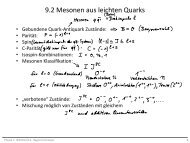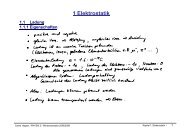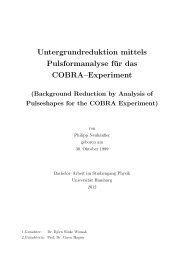Setup of a Drift Tube Muon Tracker and Calibration of Muon ...
Setup of a Drift Tube Muon Tracker and Calibration of Muon ...
Setup of a Drift Tube Muon Tracker and Calibration of Muon ...
Create successful ePaper yourself
Turn your PDF publications into a flip-book with our unique Google optimized e-Paper software.
detector is now used. Also, at least one calibration iteration should be done beforeh<strong>and</strong>(cf. Section 3.7). For each wire the residuals δ as well as the information <strong>of</strong>the corresponding track α <strong>and</strong> p is considered. A possible systematic shift is investigatedfor all wires. For a wire at the coordinates ξ w , ζ w it is first checked, whetherthe track passed the tube above or below the wire. Therefore the ζ-coordinate <strong>of</strong>the track at ξ w is calculated:ζ(ξ w ) = p − ξ w cos α.sin αNow the ξ <strong>and</strong> ζ projections <strong>of</strong> the residual δ need to be determined. Due to thedefinition <strong>of</strong> the Hesse form, the angle α cannot be used directly for this task, butis transformed to an angle β between the ζ w = 0 axis <strong>and</strong> the normal vector <strong>of</strong> thetrack through the wire coordinates. For ζ(ξ w ) − ζ w ≥ 0, β simply reduces to α ifα ≤ π <strong>and</strong> α − π if α > π. In the case <strong>of</strong> ζ(ξ w ) − ζ w < 0, β is given by α if α > π<strong>and</strong> α + π if α ≤ π. A possible shift ∆ξ <strong>and</strong> ∆ζ <strong>of</strong> the wire is then given by:∆ξ = −δ cos β∆ζ = −δ sinβ.This procedure is done for all wires <strong>and</strong> all hits <strong>of</strong> the alignment run, convenientlystored in TAnaData. Finally, one obtains distributions <strong>of</strong> ∆ξ <strong>and</strong> ∆ζ for each wirewhich have a peak around the true shift <strong>of</strong> the coordinates. These are fitted by aGaussian <strong>and</strong> the wire positions are corrected by the mean value.3.7 <strong>Calibration</strong>Although a fairly good reconstruction is already possible after the initial calibrationdescribed in Section 3.5.3, the TDC count to distance relation can still be improvedthrough further calibration steps. The initial calibration is based on the assumptionthat the electron avalanche causing the signal starts at the point <strong>of</strong> the trackwhere the distance to the anode wire is shortest. This idealization is not correct.When the particle crosses the tube, clusters <strong>of</strong> ionized molecules build up. Theseclusters are not homogeneously distributed along the track. Therefore the nearestionization cluster does not necessarily lie closest to the anode wire, the measureddrift circle can thus be overestimated by this effect. The drift times are also effectedby diffusion <strong>of</strong> the drifting electrons. Multiple scattering within the drift gas c<strong>and</strong>eflect the electrons from the direct track to the anode wire thus prolonging the drifttime. These effects, together with uncertainties in both the exact wire positions <strong>and</strong>the drift time measurement, are the reason why the initial calibration needs to becorrected. This is done using the reconstructed data itself. Also, the resolutionfunction can be determined from this. It is assumed that the reconstructed tracksare indeed the true muon tracks. Hence, the TDC count to distance relation can bederived for each hit <strong>of</strong> a wire at the position (ξ i ,ζ i ) by the reconstructed distanced = ξ i cos α + ζ i sin α − p for the corresponding TDC count t c . The distribution <strong>of</strong>all calculated distances in dependence <strong>of</strong> the TDC value can be directly obtainedform TAnaData.To calculate the new TDC count to distance relation, all pairs <strong>of</strong> TDC value<strong>and</strong> distance are drawn in a scatter plot as depicted in Fig. 3.12. The mean value43





